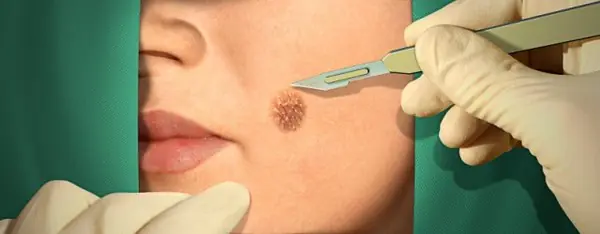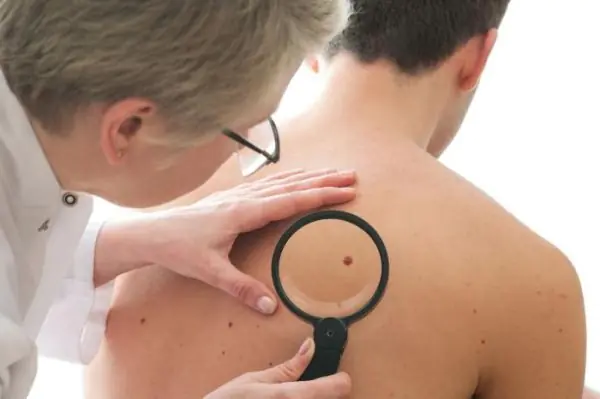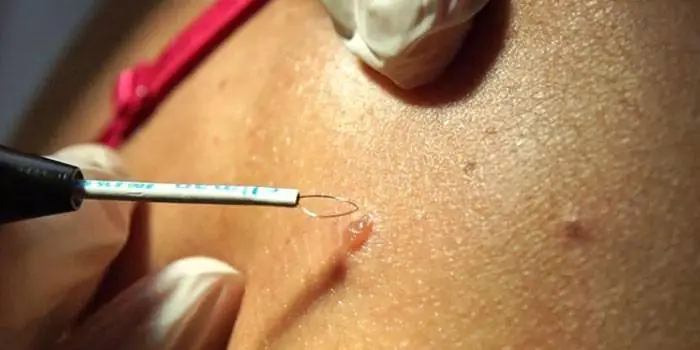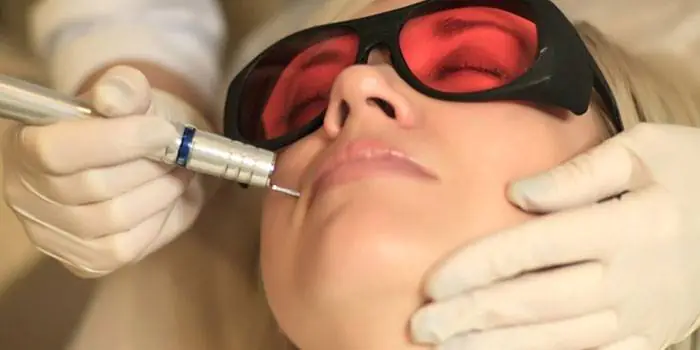Large moles, which are often injured, cause discomfort, and are prone to malignant degeneration must be removed. Patients are apprehensive about surgery. Modern methods of destruction of benign skin tumors are performed on an outpatient basis, are almost painless and rarely provoke the development of complications. What is the best way to remove a mole, and what treatment method should I choose?
Indications for removal of nevi

Most often, people with large tumors on the face or body ask to remove the growth; pigmented nodes can be very large in size, often bleed due to friction with clothing and simply cause aesthetic discomfort.
When to remove moles:
- fuzzy outline;
- frequent mechanical injuries;
- rapid growth and change in color and consistency of the mole;
- pain, itching, discharge of ichor in the area of the growth;
- uneven coloring;
- the formation of an inflamed corolla around the mole;
- the appearance of nodules and black spots on the surface;
- formation of cracks, ulcers and pronounced thickening of moles;
- localization of nevi on the eyelids, in the scalp, on the soles of the feet.
Before removal, it is recommended to consult a dermatologist or oncologist.
The doctor will perform a dermatoscopy, assess the condition of the tissue, and after excision, send the material for histological examination to exclude the possibility of developing melanoma.
Removal methods
There are several ways to get rid of nevi on the face and body. These are radio wave surgery, cryodestruction, electrocoagulation and laser therapy. Classical cutting out of the growth with a scalpel is now performed in rare cases, only when there is a suspicion of malignant degeneration and if the size of the mole is very large.

What is the best method for removing moles? One of the effective methods of treatment is the exposure of pathological tissue to high-frequency currents. The procedure lasts no more than 20 minutes, is practically painless, and sensitive patients are given local anesthesia. Since during the operation all small vessels of the skin are coagulated, bleeding does not occur.
Burning out moles is carried out with a special device - an electrocoagulator, equipped with a loop that can heat up to high temperatures under the influence of current. The loop is placed on the base of the growth and is applied for a short time.
The treated tissues become crusty, gradually die and fall off. After the scales come off, a light, pink spot with a smooth surface remains. The wound heals completely in 2–3 weeks; during this period it must be lubricated with antiseptics and healing ointments. Possible complications include the development of an inflammatory process, suppuration, and the formation of scars after cauterization of large nevi.
What are the best and most painless methods for removing moles? A good alternative to classic surgical excision is cryodestruction. The essence of the technique is to expose hyperpigmented growths to low temperatures. The fluid in the tissues freezes, membranes are destroyed, cell activity and blood microcirculation stop. Using a small nozzle, liquid nitrogen is sprayed onto the mole without affecting healthy areas.
Cryodestruction is contraindicated in the following cases:
- exacerbation of concomitant diseases of internal organs;
- inflammation, tissue suppuration;
- infectious, viral diseases;
- diabetes.
If it is necessary to remove a large mole or the patient has a low pain threshold, local anesthesia is given with Novocaine or Lidocaine. The procedure takes 5–10 minutes; after cauterization, the node becomes whitish. The next day it swells, turns red, and blisters form, this indicates the effectiveness of the procedure and the beginning of the necrotic process. Gradually the growth will darken and fall off.
The disadvantages of this method of removing moles include the possibility of secondary infection, the formation of scars, the appearance of bald spots on the scalp, and pain after the procedure. Quite rarely, nerve endings are affected. If the tissue has not been treated to sufficient depth, a new mole may grow. In such cases, repeated cauterization is required.

What are the safest methods for removing moles on the face? With non-contact treatment methods, the risk of infection and the development of postoperative complications is reduced. These types of destruction include radio wave exposure.
High-frequency waves generate thermal energy and evaporate fluid from soft tissues. The procedure does not cause pain or bleeding. In the postoperative period, complications arise in isolated cases; no scars remain on the skin, recovery occurs in a short time, and no special care for the wound is required. The excised fragment is not damaged and can be sent for histological examination.
Moles cannot be removed using radio wave destruction during pregnancy, with herpetic eruptions, chronic diseases of the dermis, or suspected malignancy.

The best method for removing moles is laser cauterization. The procedure is carried out non-contactly, the pathological growth is exposed to a carbon dioxide ray, this leads to the evaporation of fluid from the tissues and destruction of the nevus. The laser destroys only hyperpigmented melanocytes; surrounding cells are not damaged.
The treatment does not require pain relief, lasts 15–20 minutes, does not cause the development of postoperative complications, has a small number of contraindications, the skin heals quickly, since the therapy stimulates the renewal of the epidermis and accelerates metabolic processes. After removing a mole, there are no scars left, eliminating the possibility of relapse. The scab falls off within a week, leaving a light pink spot in its place. Compared to other treatment methods, laser therapy is the least dangerous.
The carbon dioxide ray destruction method can be used only if you need to remove small moles up to 5 cm in diameter, and when there are no signs of malignancy. During cauterization, the tissue is completely destroyed, and it is not possible to conduct a histological examination. You can get rid of large growths using an electrocoagulator.

If cancerous degeneration of growths is suspected, it is recommended to excise them using the classical method. This technique allows you to cut out deep, very large nevi, thereby eliminating the risk of recurrence of tumors.
The operation is performed under local anesthesia, the mole is excised within healthy tissue, the wound is treated with antiseptics and, if necessary, sutured. The removed material is sent to the laboratory for research. The recovery period is long, it is necessary to monitor the condition of the skin, apply anti-inflammatory ointments, and remove stitches.
After surgical excision, scars often remain, especially if hygiene rules are violated and an attempt is made to tear off the crust. Complete epithelization occurs within 1 month. New fabrics are light and easily pigmented when exposed to direct sunlight.
Folk remedies

What is the best way to remove moles? Is it possible to use folk recipes to cauterize the growths? You cannot carry out any impact on nevi without first consulting an oncologist, since malignant moles can begin to progress faster and cause severe complications.
Small moles on the body can be removed using celandine juice. Apply 1-2 drops of herbal remedy to the surface of the growth 2-3 times a day. This drug has a cauterizing and antibacterial effect, the tissues gradually die and are destroyed. It is important to prevent the formation of a deep burn so that a scar does not remain later.
Moles and plant acids will be removed; the skin should be lubricated with lemon, tomato, garlic juice, and 9% table vinegar. An ointment made from egg yolks and pumpkin seed oil and a solution of hydrogen peroxide help well. A mixture of chalk and hemp oil painlessly removes small moles, warts and papillomas.
What are the dangers of removing moles?

Self-cauterization of nevi at home can lead to complications:
- bleeding;
- scar formation;
- infection, tissue suppuration;
- malignancy.
Only a doctor can determine the likelihood of developing a cancerous tumor and choose the right method for removing skin tumors. If melanoma is suspected, laboratory tests are ordered, and the excised tissue is checked for the presence of cancer cells.
The best way to remove moles with laser or electrocoagulation is determined by the oncologist after examining the patient. The treatment method is selected individually for each patient, taking into account the size, consistency and location of the growth.
Medical expert article
Very often, moles on the body cause discomfort, for example, when wearing clothes or jewelry. And aesthetically, such formations are not always appropriate. A few decades ago, mole removal was carried out only surgically - using a scalpel. Nowadays, you can remove an unwanted nevus in a variety of ways, after consulting with a doctor.
[1], [2], [3], [4], [5], [6], [7], [8]
Is mole removal dangerous?
In many cases, the very existence of a mole can be more dangerous than its removal. Despite the fact that birthmarks are benign formations, under certain conditions they can degenerate into melanoma - a cancerous tumor.
However, this does not mean that it is necessary to remove absolutely all nevi on the body. It is advisable to get rid of only potentially dangerous formations:
- exposed to constant injury from clothing or accessories;
- periodically disturbing for other reasons.
Don't worry that the surgery will cause new birthmarks to appear - it won't. Moreover, some stains may be so unfavorable that they must be removed.
It can be dangerous to get rid of moles yourself at home, using traditional methods, as well as using the services of a non-specialist - a person who does not have the appropriate education and skills.
What indications are considered sufficient for mole removal?
- Noticeable growth of a birthmark in a relatively short period.
- Change in spot color (both lightening and darkening).
- Development of the inflammatory process (redness, swelling).
- The appearance of blood, ulcers and other elements on the surface of the birthmark.
- Asymmetry of the spot.
- The appearance of peeling, crusts, blisters.
- Change in nevus consistency (hardening, softening).
- The size of the mole is too large.
- Location in areas of friction with clothing or other traumatic areas.
Any of the listed symptoms is considered a direct indication for mandatory elimination of the tumor.
Is special preparation required for the removal procedure?
If the birthmark is removed for aesthetic reasons, then special preparation may not be required. The doctor will examine the formation, assess its condition and depth, and then choose the most optimal method of removal.
If a nevus is removed on suspicion of a malignant formation, then preparation may include certain tests and research.
What tests need to be done to remove a mole? It depends on the individual patient. In most cases, the following types of diagnostics may be needed:
- general blood analysis;
- coagulogram (study of the blood coagulation system);
- blood test for tumor markers.
If necessary, if local anesthesia is planned, a drug reaction test may be performed to avoid allergies to anesthetic drugs. Most often, doctors use lidocaine-based products for this.
What kind of doctor removes moles?
Mole removal can be performed by a general surgeon in any hospital or clinic, as well as by specialized specialists:
It is much safer to carry out the procedure in medical institutions, where all the necessary equipment is available that supports most of the most common methods of getting rid of moles. In such medical centers, the doctor will be able to carry out the necessary diagnostics and select the most appropriate type of treatment for a particular patient.
It is strongly not recommended to remove tumors in dubious salons, or to trust your health to incompetent persons without the appropriate education and experience - this can be dangerous.
Mole removal methods: which one to choose?
There are many known ways to remove a mole. Each of these methods has its own indications, positive and negative sides. You can get rid of a birthmark using a scalpel, laser or “electronic knife”. Typically, the choice of method is made together with the doctor who will perform the procedure.
- Laser mole removal is a quick and effective way to get rid of unwanted skin lesions. One session is enough for this. In this case, healthy skin is not affected, so there are no scars left after removal, and the risk of bleeding is reduced to zero. A few months after the laser procedure, only a barely noticeable spot remains.
- Removing moles with nitrogen (cryodestruction method) is not a very popular method, which sometimes does not allow the tumor to be removed in one procedure, since it is not possible to accurately determine the depth of tissue damage by nitrogen. In addition, sometimes after the removal procedure there is a thermal burn, after which a trace of scar tissue may remain. Removal of moles by cryodestruction has a long recovery period for the skin, however, the low price of this method is often the main criterion for choosing patients.
- Surgical removal of a mole is the only method that allows a patient to be qualitatively relieved of deep-lying and large-sized formations on the skin. Most often, mole removal with a scalpel is carried out on areas of the skin hidden under clothing, since a scar usually remains after the operation. The size of the scar depends on the initial size of the birthmark and the extent to which the surgeon has captured nearby healthy tissue. The huge advantages of this method are its relatively low cost, guaranteed quality of removal, and the ability to send the resulting tissue elements for histological examination.
- Radio wave removal of moles is also called the radiosurgical method - this is a non-contact procedure for treating tissue and removing moles using a radio knife, that is, removal using radio waves. A radioknife is a special electrode, at the end of which energy is generated that heats and evaporates tissue. Radio wave removal of moles is considered a gentle method that does not leave behind scars and scars, and healing occurs quickly and without complications.
- Removing a mole by electrocoagulation is a thermal effect on the desired area of skin using high-frequency current. The essence of the method is to apply current and heat a special platinum loop to 200°C. With this loop, the doctor performs the procedure using “cutting” and “coagulation” waves. Removing moles with electric current allows you to “cut off” unnecessary tissue, exposing a small wound. This wound heals by primary intention and leaves virtually no scar.
Technique: how is a mole removed?
Important: removal of a birthmark should only be carried out by a specialist with relevant experience. Getting rid of nevi on your own can have serious consequences.
Any of the selected procedures is performed under local anesthesia - using an injection of an anesthetic or a special external anesthetic gel.
Removal of moles on the face is most often performed with a laser. This method allows you to eliminate the tumor without further scar formation. The procedure itself lasts only a few minutes, so, if desired, the doctor can simultaneously remove several formations at once. Within five minutes after the session, the patient can go home.
Removal of hanging moles is usually carried out using electrocoagulation. The entire session lasts no longer than 15-20 minutes, which depends on the diameter and number of birthmarks to be removed. Before the procedure, the doctor administers anesthesia by applying a special anesthetic gel or by injection. Next, by heating the tungsten electrode with an electric discharge, the hanging formation is “cut off” at once. Healthy tissues located in close proximity are cauterized, which prevents bleeding from the wound. The material obtained after removal can be sent for histology, and the wound itself usually heals within one week. Convex moles can be removed in a similar way if they are small and not particularly deep.
Removal of large moles is carried out only surgically. This operation is performed under local anesthesia, and all removed tissue elements are sent for histology (to exclude or confirm a cancerous tumor). The entire area around the formation is treated with an antiseptic. During the operation, the doctor partially cuts off healthy tissue to prevent regrowth of the birthmark. After this, suture material is applied, which is removed after about one week. The operated patient can immediately go home, but he will have to visit the doctor several more times for dressings and suture removal.
Removal of moles with histological examination is a mandatory procedure for a surgeon if a malignant tumor is suspected. Only such a study will help detect even the initial stage of tissue degeneration, cancerous and precancerous processes. In order to send tissue for research, it must be as intact as possible. Therefore, histology is possible only when tumors are removed surgically or using electrocoagulation.
Removing moles in children is done using the same methods as in adults. The choice of procedure is determined depending on the patient’s age and his individual sensitivity threshold, as well as on some psychological aspects of upbringing. Often, especially when working with young children, doctors prefer to use less traumatic methods - gluing plasters, applying keratolytic preparations, etc. The effectiveness of such procedures is noticeably lower, and the birthmark, having disappeared, may appear again. However, the choice of removal technique remains with the doctor who will directly deal with a particular child. They try to remove tumors when the child reaches adolescence. However, if they cause certain inconvenience to the baby, or if the moles behave unnaturally, they are removed at any period of the little patient’s life.
Moles can be removed for two reasons: aesthetic or medical. Is it worth doing? If there are signs of melanoma, the doctor will advise removing the dark or red formation. In other cases, small spots on the body do not pose any threat.
Is it possible to remove moles?
Benign age spots in themselves are not dangerous as long as they retain a clear shape, remain flat and have a characteristic brown color. Some of them begin to grow over time. There is nothing supernatural about this either. Most people try to remove a mole when it attracts attention, is located in the face, neck, cheeks, around the eyes and spoils the appearance in life and in photos.
Some lesions are warts or seborrheic keratoses. Do moles of this kind need to be removed? A dermatologist treats them by freezing or cauterizing, but dangerous nevi can only be removed surgically when there are special indications for this:
- increase in growth in size;
- color change (discoloration, redness, streaks);
- change of form;
- the appearance of itching;
- bleeding
Mole removal methods
Before getting rid of a tumor, you should study the reasons for its appearance. Some people are born with moles, while others experience them throughout their lives. Exposure to ultraviolet rays can negatively affect existing growths: you should not stay in the sun for long to prevent spots from appearing. Heredity also cannot be ruled out, since many people pass on the characteristic mark to their offspring.
There are certain methods for removing moles, each of them should be considered individually by a specialist. The most popular methods include:
- cryodestruction (cauterization with nitrogen);
- electrocoagulation (using radio waves);
- nevus removal with laser;
- surgery.

Laser mole removal
The innovative method is considered the fastest and most painless. Thanks to local anesthesia, a patient with such a dark formation will not feel anything. The process takes place in stages: ablative equipment removes the tubercle layer by layer. However, laser removal of moles is not so safe: after the procedure, a hole appears, which gradually heals, but not always. The beam destroys all the tissue of the mole, leaving nothing for oncological research, but the patient is left with a noticeable scar as a souvenir.
Nevi located on the face deserve special attention. They should only be removed by a qualified professional to avoid leaving keloid scars. After removing a mole, you need to be careful: you should protect the area affected by the laser from direct sunlight, covering this area with a plaster. When the rehabilitation period is over, the protection can be removed.
Removing moles using the radio wave method
High-frequency vibrations, which are transmitted through tissue, cause minimal damage to the surrounding skin surface - significantly less than with a surgical scalpel. Radio wave removal of moles does not require stitches or bandages. After treatment, a small wound remains on the body, covered with a dense crust. After some time, it heals, leaving a small spot, which also gradually disappears. The process of tightening the scar takes from 3 days to 2 weeks.
The radiosurgical method is suitable for eliminating deep skin formations, including:
- keratosis,
- warts,
- fibroids,
- moles,
- facial capillaries or spider veins,
- papillomas,
- scars left after acne.

Mole removal with nitrogen
You can hear dubious reviews about cryodestruction. Some say the method is effective, others complain of pain and left marks. How do dermatologists remove a mole? The doctor sprays a small amount of liquid nitrogen onto the lump area. Cold temperatures freeze the tissue, including the area around the mark. Because of this, swelling may remain, which will subside on its own over time.
Removing moles with liquid nitrogen is painless. The patient may need to re-process the tissue, and the wound will take much longer to heal compared to the methods described above. The doctor is not always able to control the depth of penetration of the chemical, so there is a danger of freezing the “extra” area of skin.
Surgical removal of a mole
Excision of the tubercle is considered the most painful. In order to decide on surgery, you should consult a doctor and diagnose the formation, otherwise negative consequences may occur. Is it dangerous to remove moles with a scalpel? It is riskier to leave them, as melanoma may develop. It is better to remove all excess that is on the skin and sleep peacefully.
Removing moles surgically requires not only skill, but also special care after surgery. During the rehabilitation period, it is necessary to apply bandages with an antibiotic or healing ointment, changing them 2 times a day. Do not swim or wet the healing area. Fever after surgery is common.
Mole removal - consequences
Removing a hated spot on the body is not the end of the problem: the consequences of removing moles can be very different. Some patients recover quickly, while others suffer from complications. Removing skin lesions at home does not bring anything good. The wound begins to fester, inflammation, redness, and swelling appear. Where to remove a mole without consequences? Only at the doctor's.
You should contact the clinic if the following symptoms become noticeable after the procedure:
- excessive lymph secretion, bleeding;
- the appearance of suppuration;
- strong pain;
- temperature increase;
- changes in mental state.

Price for mole removal
The cost of the procedure in Moscow depends on the medical institution; in rare cases, warts are removed free of charge. Before visiting the center, it is better to read reviews, call the reception to find out how much it costs to remove a mole, and ask about the procedure in more detail. The table shows the price range:



